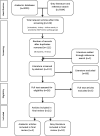Closing the birth registration gap for Every newborn facility birth: literature review and qualitative research
- PMID: 38085000
- PMCID: PMC10795615
- DOI: 10.1080/16549716.2023.2286073
Closing the birth registration gap for Every newborn facility birth: literature review and qualitative research
Abstract
Background: Birth registration is vital to provide legal identity and access to essential services. Worldwide, approximately 166 million children under five years (just under 25%) are unregistered, yet >80% of all births occur in health facilities in most low- and middle-income countries (LMIC).
Objectives: This study, conducted in association with UNICEF, aims to review facility-based birth registration initiatives, and provide recommendations to close the gap between facility birth and birth registration rates in LMIC.
Methods: A literature review covering published and grey literature was conducted to identify facility-based initiatives to increase birth registration rates. Semi-structured in-depth interviews were conducted by audio-call with six key global stakeholders to identify additional initiatives, and further insights for barriers and enablers to close the gap.
Results: Academic databases and grey literature search yielded 21 studies meeting pre-specified inclusion criteria. Nine barriers preventing birth registration were identified and grouped into three themes: health system, governmental, and societal barriers. Facility-based birth registration initiatives resulted in an increase in birth registration rates. Importantly, health promotion within communities also increased demand for birth registration. In-depth interview respondents provided further detail and supported data found in literature review. Synthesis of the literature and stakeholder interviews noted enablers including inter-sectoral collaboration between health sector and civil registration ministries e.g., placing civil registration offices in health facilities or allowing medical doctors to act as registrars.
Conclusion: Facility-based birth registration initiatives can increase birth registration rates in LMIC. Initiatives need to address both supply and demand side of birth registration to improve facility-based birth registration rates. A multi-sectoral approach within governments, and alignment with multiple stakeholders is vital.
Keywords: CRVS; LMIC; birth registration; facility-based; newborn.
Conflict of interest statement
No potential conflict of interest was reported by the author(s).
Figures




References
-
- UNICEF . Birth Registration for Every Child by 2030 : Are we on track? 2019;44.
-
- United Nations . World population prospects - population division - United Nations [Internet]. 2019. [cited 2020 May 31]. Available from: https://population.un.org/wpp/DataQuery/
-
- Amo-Adjei J, Annim SK.. Health-care seeking behaviour among persons with diabetes in Uganda: an interview study. 2011. [cited 2018 Feb 19]. Available from: https://www.ncbi.nlm.nih.gov/pmc/articles/PMC4465725/pdf/12914_2015_Arti... - PMC - PubMed
-
- World Bank Data Team . New country classifications by income level: 2016-2017 | the data blog [Internet]. World Bank Data Blog. 2016. [cited 2018 Aug 1]. Available from: http://blogs.worldbank.org/opendata/new-country-classifications-2016
-
- GSMA . Birth Registration in Tanzania [Internet]. United Kingdom; 2016. [cited 2018 Feb 19]. Available from : https://www.gsma.com/mobilefordevelopment/wp-content/uploads/2016/07/Bir...
Publication types
MeSH terms
LinkOut - more resources
Full Text Sources
Miscellaneous
